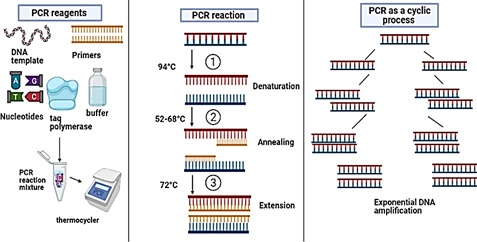Molecular Diagnostic Strategies Used for the Detection of Microbial Pathogens in Human Beings: A Review
Abstract
 Abstract Views: 0
Abstract Views: 0
Background: Viral diseases pose a serious health hazard to human population, worldwide. A perfect illustration of how a viral infection could pose a serious threat to public health and economic sectors is the current COVID-19 outbreak brought on by SARS-CoV-2 in 2019. Consequently, obtaining a prompt and accurate diagnosis is the first step in treating infections. For effective treatment, epidemic control, and prevention, early and precise identification of microbial presence in patient samples is essential.
Methods: This study lists some of the molecular and immunological diagnostic methods that can be used to find infections in human beings. Rapid viral detection in patient samples is possible by the use of molecular diagnostic techniques. These techniques are also reasonably cheap, quite sensitive, and very targeted. Infections in human beings have been detected and the epidemiology of these illnesses has been widely studied using immunologically based methods.
Results: In clinical samples, these methods can identify viral antigens or antiviral antibodies. Many commercially accessible molecular and immunological diagnostic kits make it easier to employ these techniques in most clinical laboratories around the world.
Conclusion: This review offers a new perspective on molecular techniques employed in the application of the clinical diagnostics of microbes.
Downloads
References
Reta DH, Tessema TS, Ashenef A, et al. Molecular and immunological diagnostic techniques of medical viruses. Int J Microbiol. 2020;2020:e8832728. https://doi.org /10.1155/2020/8832728
Amann RI, Ludwig W, Schleifer KH. Phylogenetic identification and in situ detection of individual microbial cells without cultivation. Microbiol Rev. 1995;59(1):143–169. https://doi.org /10.1128/mr.59.1.143-169.1995
Wade WG. Non-culturable bacteria in complex commensal populations. Adv Appl Microbiol. 2004;54:93–106.
Umesha S, Manukumar HM. Advance molecular diagnostic techniques for the detection of food borne pathogens; Current applications and future challenges. Cri Rev Food Sci Nutr. 2018;58(1):84–104. https://doi.org /10.1080/10408398.2015.1126701
Mohr O’Hara C, Weinstein MP, Miller JM. Manual and automated systems for detection and identification of microorganisms, in Manual of Clinical Microbiology. Clin Microbiol Rev. 2003;18(1):147–162. https://doi.org/10.1128 %2FCMR.18.1.147-162.2005
Falkow S. Molecular Koch’s postulates applied to bacterial pathogenicity-a personal recollection 15 years later. Nat Rev Microbiol. 2004;2:67–72. https://doi.org/ 10.1038/nrmicro799
Poste G. Molecular diagnostics: a powerful new component of the healthcare value chain. Expert Rev Mol Diagn. 2001;1(1):1–5. https://doi.org /10.1586/14737159.1.1.1
Galluzzi L, Magnani M, Saunders N, Harms C, Bruce IJ. Current molecular techniques for the detection of microbial pathogen. Sci Progress. 2007;90(1):29–50. https://doi.org /10.3184/003685007780440521
Aslam S, Tahir A, Aslam MF, Aslam MW, Shedayi AA, Sadia S. Recent advances in molecular techniques for the identification of phytopathogenic fungi-a mini review. J Plant Interact. 2017;12(1):493–504. https://doi.org/ 10.1080/17429145.2017.1397205
Henson JM, French R. The polymerase chain reaction and plant disease diagnosis. Ann Rev Phytopathol. 1993;31(1):81–109.
Bhat R, Browne G. Specific detection of Phytophthora cactorum in diseased strawberry plants using nested polymerase chain reaction. Plant Pathol. 2010;59(1):121–129. https://doi.org/10.1111/j.1365-3059.2009.02147.x
Jabbar A, Zulfiqar F, Mahnoor M, Mushtaq N. Advances and perspectives in the application of CRISPR-Cas 9 in Livestocks. Mol Biotechnol. 2021; 63(1):757–767. https://doi.org/10.1007/s12033-021-00347-2
Siqueira JF, Rocas NI. PCR methodology as a valuable tool for identification of endodontic pathogens. J Dent. 2003;31:333–339. https://doi.org/10.1016/S0300-5712(03)00051-4
Rahman MT, Uddin MS, Sultana R, Moue A, Setu M. Polymerase chain reaction (PCR): a short review. Anwer Khan Modern Medical College J. 2013;4(1):30–36. https://doi.org/10.3329/akmmcj.v4i1.13682
Trtkova J, Raclavsky V. Molecular-genetic approaches to identification and typing of pathogenic Candida yeasts. Biomed Pap Med Fac Univ Palacky Olomouc Czech Repub. 2006;150(1):51–61.
Tsai HL, Huang LC, Ann PJ, Liou RF. Detection of orchid Phytophthora disease by nested PCR. Bot Stud. 2006;47(4):379–387.
Jaeger EE, Carroll NM, Choudhury S, et al. Rapid detection and identification of Candida, Aspergillus, and Fusarium species in ocular samples using nested PCR. J Clin Microbiol. 2000;38(8):2902–2908. https://doi. org/10.1128/jcm.38.8.2902-2908.2000
Capote N, Aguado A, Pastrana AM, Sánchez-Torres P. Molecular tools for detection of plant pathogenic fungi and fungicide resistance. In: Cumagun CJ, ed. Plant Pathology. Intechopen; 2012;151–202.
Eshaque B, Dixon B. Technology platforms for molecular diagnosis of cystic Õbrosis. Biotechnol Adv. 2006;24(1):86–93. https://doi.org/ 10.1016/j.biotechadv.2005.08.003
De Clerck E, Van Mol K, Jannes G, Rossau R, De Vos P. Design of a 5¢ exonuclease-based real-time PCR assay for simultaneous detection of Bacillus licheniformis, members of the ‘B. cereus group’ and B. fumarioli in gelatine. Lett Appl Microbiol. 2004;39(1):109–115. https://doi.org/ 10.1111/j.1472-765X.2004.01550.x
Massart S, De Clercq D, Salmon M, Dickburt C, Jijakli MH. Development of real-time PCR using Minor Groove Binding probe to monitor the biological control agent Candida oleophila (strain O). J Microbiol Methods. 2005;60(1):73–82. https:// doi.org/10.1016/j.mimet.2004.08.012
Bottger EC. Rapid determination of bacterial ribosomal RNA sequences by direct sequencing of enzymatically amplified DNA. FEMS Microbiol Lett. 1989;65(1-2):171–176. https://doi.org/ 10.1111/j.1574-6968.1989.tb03617.x
Schabereiter-Gurtner C, Nehr M, Apfalter P, Makristathis A, Rotter ML, Hirschl AM. Evaluation of a protocol for molecular broad-range diagnosis of culture-negative bacterial infections in clinical routine diagnosis. J Appl Microbiol. 2008;104(4):1228–1237. https://doi.org/10.1111/j.1365-2672.2007.03648.x
Relman DA, Schmidt TM, MacDermott RP, Falkow S. Identification of the uncultured bacillus of Whipple’s disease. N Engl J Med. 1992;327(5):293–301. https://doi.org/ 10.1056/NEJM19920730327050
Kornreich BG, Craven M, McDonough SP. Fluorescence in-situ hybridization for the identification of bacterial species in archival heart valve sections of canine bacterial endocarditis. J Comp Pathol. 2012;146(4):298–307. https://doi.org/ 10.1016/j.jcpa.2011.07.006
Shivaprasad HL, Cadenas MB, Diab SS. Coxiella-like infection in psittacines and a toucan. Avian Dis. 2008;52(3):426–432. https://doi.org/ 10.1637/8192-120707-Reg
Healy M, Huong J, Bittner T, Lising M, Frye S, Raza S. Microbial DNA typing by automated repetitive-sequence-based PCR. J Clin Microbiol. 2005;43(1):199–207. https://doi.org/10.1128/jcm.43.1.199-207.2005
Sabat AJ, Budimir A, Nashev D, Sa-Leao R, Van Dijl J, Laurent F. Overview of molecular typing methods for outbreak detection and epidemiological surveillance. Eurosurveillance. 2013;18(4):e20380. https://doi.org/10.2807/ese.18.04.20380-en
Brossier F, Micaelo M, Luyt CE, Lu Q, Chastre J, Arbelot C. Could the DiversiLab(R) semi-automated repetitive-sequence-based PCR be an acceptable technique for typing isolates of Pseudomonas aeruginosa? An answer from our experience and a review of the literature. Can J Microbiol. 2015;61(12):903–912. https://doi.org/10.1139/cjm-2015-0372.
Harrington SM, Stock F, Kominski A, Campbell J, Hormazabal J, Livio S. Genotypic analysis of invasive Streptococcus pneumoniae from Mali, Africa, by semiautomated repetitive-element PCR and pulsed-field gel electrophoresis. J Clin Microbiol. 2007;45(3):707–714. https://doi.org /10.1128/jcm.01871-06
Sobral D, Mariani-Kurkdjian P, Bingen E, Vu-Thien H, Hormigos K, Lebeau B. A new highly discriminatory multiplex capillary-based MLVA assay as a tool for the epidemiological survey of Pseudomonas aeruginosa in cystic fibrosis patients. Eur J Clin Microbiol Infect Dis. 2012;31:2247–2256. https://doi.org/10.1007/s10096-012-1562-5
Keim P, Price LB, Klevytska AM, Smith KL, Schupp JM, Okinaka R. Multiple-locus variable-number tandem repeat analysis reveals genetic relationships within Bacillus anthracis. J Bacteriol. 2000;182(10):2928–2936. https://doi.org/10.1128/jb.182.10.2928-2936.2000
Chen JW, Lau YY, Kishnan T, Chan KG, Chang CY. Recent advances in molecular diagnosis of Pseudomonas aeruginosa infection by State-of-the-art genotyping techniques. Front Microbiol. 2018;9:e378358. https://doi.org/10.3389/fmicb.2018.01104
Ramamurthy M, Alexander M, Aaron S. Comparison of a conventional polymerase chain reaction for the detection of neurotropic viruses in cerebrospinal fluid samples. Ind J Med Microbiol. 2011;29(2):102–109. https://doi.org/10.4103/0255-0857.81777
Souf S. Recent advances in diagnostic testing for viral infections. Biosci Horizons. 2016;9:ehzw010. https://doi.org/10.1093/biohorizons/hzw010
Nakhaie M, Soleimanjahi H, Mollaie H, Arabzadeh S. Development of multiplex reverse transcription-polymerase chain reaction for simultaneous detection of influenza A, B and adenoviruses. Iran J Pathol. 2018;13(1):54–62.
Shen M, Zhou Y, Ye J, et al. Recent advances and perspectives of nucleic acid detection for coronaviruses. J Pharm Anal. 2020;10(2):97–101. https://doi.org/10.1016/j.jpha.2020.02.010
Boppana SB, Ross SA, Shimamura M, et al. Saliva polymerase-chain-reaction assay for Cytomegalovirus screening in newborns. New Eng J Med. 2011;364(22):2111–2118. https://doi.org/10.1056/NEJMoa1006561
Southern EM. Detection of specific sequences among DNA fragments separated by gel electrophoresis. J Mol Biol. 1975;98(3):503–517. http://www.theses.ulaval.ca/2004/21483/21483014.png
Bhagavan NV. Medical Biochemistry. Acadmic Press; 2002.
Berg JM, Tymoczko JL, Stryer L. Biochemistry (Loose-Leaf). Macmillan; 2007.
Wu TC, Lee WA, Pizzorno MC, et al. Localization of the human cytomegalovirus 2.7-kb major early ß-gene transcripts by RNA in situ hybridization in permissive and non-permissive infections. Am J Pathol. 1992;141(5):1247–1254.
Li JJ, Huang YQ, Cockerell CJ. Localization of human herpes-like virus type 8 in vascular endothelial cells and perivascular spindle-shaped cells of Kaposi’s sarcoma lesions by in situ hybridization. Am J Pathol. 1996;148(6):1741–1748.
Prange E, Trautmann JC, Kreipe H. Detection of Epstein-Barr virus in lymphoid tissues of patients with infectious mononucleosis by in situ hybridization. J Pathol. 1992;166(2):113–119. https://doi.org/ 10.1002/path.1711660206
Ratan ZA, Zaman SB, Mehta V, Haidere MF. Application of fluorescence in-situ hybridization (FISH) technique for the detection of genetic aberration in medical science. Cureus. 2017;9(6):e1325. https://doi.org/10.7759/cureus.1325
Wilson DA, Joyce MJ, Hall LS, et al. Multicenter Evaluation of a Candida albicans peptide nucleic acid fluorescent in situ hybridization probe for characterization of yeast isolates from blood cultures. J Clin Microbiol. 2005;43(6):2909–2912. https://doi.org /10.1128/jcm.43.6.2909-2912.2005
Yeo SF, Wong B. Current status of nonculture methods for diagnosis of invasive fungal infections. Clin Microbiol Rev. 2002;35(3):465–484. https://doi.org/10.1128/cmr.15.3.465-484.2002
Stender H. PNA FISH: an intelligent stain for rapid diagnosis of infectious diseases. Expert Rev Mol Diagn. 2003;3(5):649–655. https://doi.org/10. 1586/14737159.3.5.649
Cai H, Archambault M, Prescott JF. 16S ribosomal RNA sequence-based identification of veterinary clinical bacteria. J Vet Diagn Invest. 2003;15(5):465–469. https://doi.org/ 10.1177/104063870301500511
Woo PC, Ng KH, Lau SK. Usefulness of the MicroSeq 500 16S ribosomal DNA-based bacterial identification system for identification of clinically significant bacterial isolates with ambiguous biochemical profiles. J Clin Microbiol. 2003;41(5):1996–2001 https://doi.org/10.1128/ jcm.41.5.1996-2001.2003
Ludwig W, Schleifer KH. Bacterial phylogeny based on 16S and 23S rRNA sequence analysis. FEMS Microbiol Rev. 1994;15(2-3):155–173. https://doi.org/10.1111/j.1574-6976.1994.tb00132.x
Clarridge JE. Impact of 16S rRNA gene sequence analysis for identification of bacteria on clinical microbiology and infectious diseases. Clin Microbiol Rev. 2004;17(4):840–862. https://doi.org/10.1128 /cmr.17.4.840-862.2004
Yarza P, Yilmaz P, Pruesse E. Uniting the classification of cultured and uncultured bacteria and archaea using 16S rRNA gene sequences. Nat Rev Microbiol. 2014;12:635–645. https:// doi.org/10.1038/nrmicro3330
Kozich JJ, Westcott SL, Baxter NT, Highlander SK, Schloss PD. Development of a dual‐index sequencing strategy and curation pipeline for analyzing amplicon sequence data on the MiSeq Illumina sequencing platform. Appl Environ Microbiol. 2013;79(17):5112–5120. https://doi.org/10.1128/AEM.01043-13
Yu X, Jiang W, Shi Y, Ye H, Lin J. Applications of sequencing technology in clinical microbial infection. J Cell Mol Med. 2019;23(11):7134–7150. https://doi.org/10.1111/jcmm.14624
Zang L, Chen F, Zeng Z, Xu M. Advances in Metagenomics and its application in environmental microbiology. Frontiers Microbiol. 2021;12:e766364. https://doi.org/ 10.3389/fmicb.2021.766364
Von Wintzingerode F, Bocker S, Schlotelburg C. Base-specific fragmentation of amplified 16S rRNA genes analyzed by mass spectrometry: a tool for rapid bacterial identification. Proc Natl Acad Sci. 2002;99(10):7039–7044. https://doi. org/10.1073/pnas.102165899
Lowe CA, Diggle MA, Clarke SC. A single nucleotide polymorphism identification assay for the genotypic characterization of Neisseria meningitidis using MALDI-TOF mass spectrometry. Br J Biomed Sci. 2004;61(1):8–10. https://doi.org/ 10.1080/09674845.2004.11732638
Nakano K, Shiroma A, Shimojii M. Advantages of genome sequencing by long‐read sequencer using SMRT technology in medical area. Hum Cell. 2017;30:149–161. https://doi.org/ 10.1007/s13577-017-0168-8
Spratt BG, Maden MC. Bacterial population genetics, evolution and epidemology. Philos Trans R Soc Lond B Biol Sci. 1999;354(1384):701–710. https://doi.org/10.1098/rstb.1999.0423
Varongchayakul N, Song J, Meller A, Grinstaff MW. Single‐molecule protein sensing in a nanopore: a tutorial. Chem Soc Rev. 2018;47:8512–8524. https://doi.org/10.1039/ C8CS00106E
Squires AH, Gilboa T, Torfstein C. Single‐molecule characterization of DNA‐protein interactions using nanopore biosensors. Methods Enzymol. 2017;582:353–385. https:// doi.org/10.1016/bs.mie.2016.08.010
Tedersoo L, Tooming‐Klunderud A, Anslan S. PacBio metabarcoding of Fungi and other eukaryotes: errors, biases, and perspectives. New Phytol. 2018;217:1370–1385. https://doi.org/ 10.1111/nph.14776
Van Dijk EL, Jaszczyszyn Y, Naquin D, Thermes C. The third revolution in sequencing technology. Trends Genet. 2018;34(9):666–681. https://doi.org /10.1016/j.tig.2018.05.008
Marinov GK. On the design and prospects of direct RNA sequencing. Brief Funct Genom. 2017;16(6):326–335. https://doi.org/10.1093/ bfgp/elw043
Benkovic SJ, Cameron CE. Kinetic analysis of nucleotide incorporation and misincorporation by Klenow fragment of Escherichia coli DNA polymerase I. Methods Enzymol. 1995;262:257–269. https://doi.org/ 10.1016/0076-6879(95)62022-2
Ronaghi M, Pettersson B, Uhlen M, Nyren P. PCR-introduced loop structure as primer in DNA sequencing. BioTechniques. 1998;25(8):876–884. https://doi.org/ 10.2144/98255rr02
Ronaghi M, Karamohamed S, Pettersson B, Uhlen M, Nyren P. Real-time DNA sequencing using detection of pyrophosphate release. Anal Biochem.1996;242:84–89.
Ronaghi M. Pyrosequencing sheds light on DNA sequencing. Genome Res. 2021;11:3–11. https://doi.org/10 .1006/abio.1996.0432
Garcia AC, Ahamdian A, Gharizadeh B, Lundeberg J, Ronaghi M, Nyren P. Mutation detection by Pyrosequencing: Sequencing of exons 5 to 8 of the p53 tumor suppressor gene. Gene. 2000;253(2):249–257. https://doi.org/10.1016/S0378-1119(00)00257-2
Van der Pol B, Quinn TC, Gaydos CA, et al. Multicenter evaluation of the AMPLICOR and automated COBAS AMPLICOR CT/NG tests for detection of Chlamydia trachomatis. J Clin Microbiol. 2000;38:1105–1112. https://doi.org/10.1128/jcm.38.3.1105-1112.2000
Tortoli E, Mariottini A, Mazzarelli G. Evaluation of INNO-LiPA Mycobacteria v2: improved reverse hybridization multiple DNA probe assay for mycobacterial identification. J Clin Microbiol. 2003;41(9):4418–4420. https://doi.org/10.1128 /jcm.41.9.4418-4420.2003
Jardi R, Rodriguez-Frias F, Tabernero D, et al. Use of the Novel INNO-LiPA Line Probe Assay for Detection of Hepatitis B Virus Variants That Confer Resistance to Entecavir Therapy. J Clin Microbiol. 2009;47(2):485–488. https://doi.org/10.1128/jcm.01678-08
Martin DH, Cammarata C, Van Der Pol B, et al. Multicenter evaluation of AMPLICOR and automated COBAS AMPLICOR CT/NG tests for Neisseria gonorrhoeae. J Clin Microbiol. 2000;38(10):3544–3549.
Burgess ST, Kenyon F, O’Looney N, et al. A multiplexed protein microarray for the simultaneous serodiagnosis of human immunodeficiency virus/hepatitis C virus infection and typing of whole blood. Anal Biochem. 2008;382(1):9–15. https://doi.org /10.1016/j.ab.2008.07.017
Gaseitsiwe S, Valentini D, Mahdavifar S, et al. Pattern recognition in pulmonary tuberculosis defined by high content peptide microarray chip analysis representing 61 proteins from M. tuberculosis. PLoS ONE. 2008;3(12):e3840. https://doi.org /10.1371/journal.pone.0003840
Gouriet F, Samson L, Delaage M, et al. Multiplexed whole bacterial antigen microarray, a new format for the automation of serodiagnosis: the culture-negative endocarditis paradigm. Clin Microbiol Infect. 2008; 14:1112–1118. https://doi.org/ 10.1111/j.1469-0691.2008.02094.x
Ben RJ, Kung S, Chang FY, Lu JJ, Feng NH, Hsieh YD. Rapid diagnosis of bacterial meningitis using a microarray. J Formos Med Assoc. 2008;107(6):448–453. https://doi.org /10.1016/S0929-6646(08)60152-7
Tsui CK, Woodhall J, Chen W, et al. Molecular techniques for pathogen identification and fungus detection in the environment. IMA Fungus. 2011;2(2):177–189. https://doi.org /10.5598/imafungus.2011.02.02.09
Fakruddin M. Loop mediated isothermal amplification (LAMP)-an alternative to polymerase chain reaction (PCR). Bangladesh Res Pub J. 2011;5(4):425–439.
Ren CH, Hu CQ, Luo P, Wang QB. Sensitive and rapid identification of Vibrio vulnicus by loop-mediated isothermal amplification. Microbiol Res. 2009;164(5):514–521. https://doi. org/10.1016/j.micres.2008.05.002
Liu W, Huang S, Liu N, et al. Establishment of an accurate and fast detection method using molecular beacons in loop-mediated isothermal amplification assay. Sci Rep. 2017;7:e40125. https://doi.org/ 10.1038/srep40125

Copyright (c) 2024 Sikander Ali, Saba Mahboob, Kalsoom Tahir, Muhammad Nauman Aftab

This work is licensed under a Creative Commons Attribution 4.0 International License.
BSR follows an open-access publishing policy and full text of all published articles is available free, immediately upon publication of an issue. The journal’s contents are published and distributed under the terms of the Creative Commons Attribution 4.0 International (CC-BY 4.0) license. Thus, the work submitted to the journal implies that it is original, unpublished work of the authors (neither published previously nor accepted/under consideration for publication elsewhere). On acceptance of a manuscript for publication, a corresponding author on the behalf of all co-authors of the manuscript will sign and submit a completed the Copyright and Author Consent Form.









